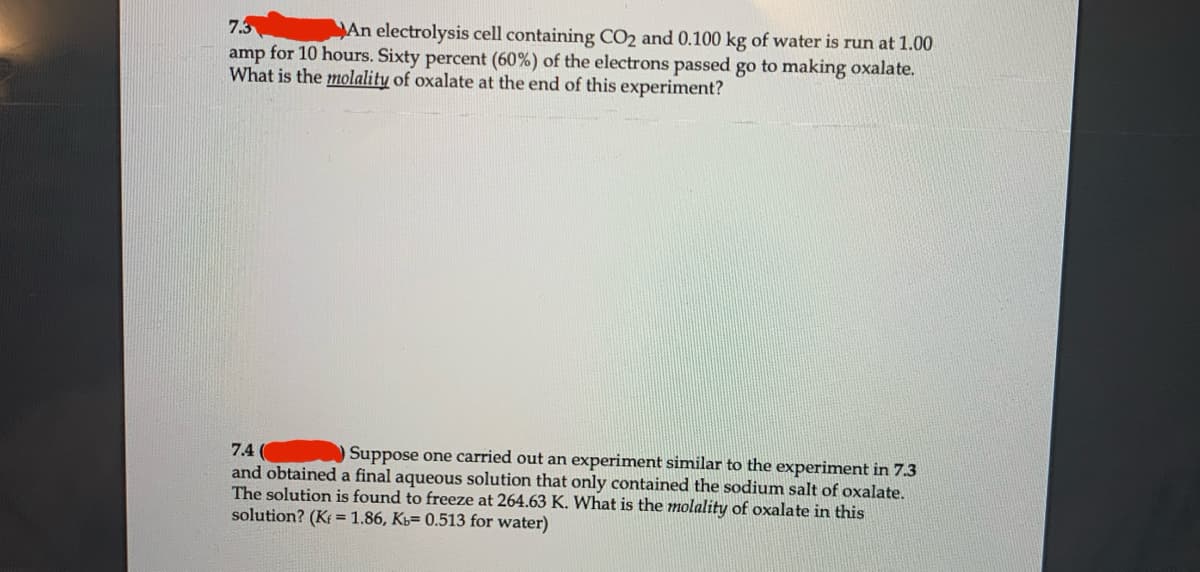Chemistry by OpenStax (2015-05-04)
1st Edition
ISBN:9781938168390
Author:Klaus Theopold, Richard H Langley, Paul Flowers, William R. Robinson, Mark Blaser
Publisher:Klaus Theopold, Richard H Langley, Paul Flowers, William R. Robinson, Mark Blaser
Chapter17: Electrochemistry
Section: Chapter Questions
Problem 48E: Identify the reaction at the anode, reaction at the cathode, the overall reaction, and the...
Related questions
Question

Transcribed Image Text:7.3
An electrolysis cell containing CO2 and 0.100 kg of water is run at 1.00
amp for 10 hours. Sixty percent (60%) of the electrons passed go to making oxalate.
What is the molality of oxalate at the end of this experiment?
7.4 (
and obtained a final aqueous solution that only contained the sodium salt of oxalate.
The solution is found to freeze at 264.63 K. What is the molality of oxalate in this
solution? (K = 1.86, Kb= 0.513 for water)
Suppose one carried out an experiment similar to the experiment in 7.3
![In class, we talked about several products that one might electrochemically convert CO2
into as a way to reduce the amount of climate-impacting CO2 in our atmosphere. One
very interesting product that we did not discuss in class is the dianion, oxalate, a
substance formed from two CO2 molecules.
Oxalate dianion
7.1
Write out a balanced half reaction for the formation of oxalate [C2O4]2-
from CO2 in water.
7.2
How many coulombs of electrons are required to reduce 2 moles of CO2 to
oxalate?](/v2/_next/image?url=https%3A%2F%2Fcontent.bartleby.com%2Fqna-images%2Fquestion%2F3d27d809-bcfd-47ad-93ad-c51ab31b4131%2F2daace6f-e8ca-4dd7-bd7f-fdb3394f906c%2Foob0enf_processed.jpeg&w=3840&q=75)
Transcribed Image Text:In class, we talked about several products that one might electrochemically convert CO2
into as a way to reduce the amount of climate-impacting CO2 in our atmosphere. One
very interesting product that we did not discuss in class is the dianion, oxalate, a
substance formed from two CO2 molecules.
Oxalate dianion
7.1
Write out a balanced half reaction for the formation of oxalate [C2O4]2-
from CO2 in water.
7.2
How many coulombs of electrons are required to reduce 2 moles of CO2 to
oxalate?
Expert Solution
This question has been solved!
Explore an expertly crafted, step-by-step solution for a thorough understanding of key concepts.
Step by step
Solved in 2 steps with 1 images

Knowledge Booster
Learn more about
Need a deep-dive on the concept behind this application? Look no further. Learn more about this topic, chemistry and related others by exploring similar questions and additional content below.Recommended textbooks for you

Chemistry by OpenStax (2015-05-04)
Chemistry
ISBN:
9781938168390
Author:
Klaus Theopold, Richard H Langley, Paul Flowers, William R. Robinson, Mark Blaser
Publisher:
OpenStax

General Chemistry - Standalone book (MindTap Cour…
Chemistry
ISBN:
9781305580343
Author:
Steven D. Gammon, Ebbing, Darrell Ebbing, Steven D., Darrell; Gammon, Darrell Ebbing; Steven D. Gammon, Darrell D.; Gammon, Ebbing; Steven D. Gammon; Darrell
Publisher:
Cengage Learning

Chemistry: Principles and Reactions
Chemistry
ISBN:
9781305079373
Author:
William L. Masterton, Cecile N. Hurley
Publisher:
Cengage Learning

Chemistry by OpenStax (2015-05-04)
Chemistry
ISBN:
9781938168390
Author:
Klaus Theopold, Richard H Langley, Paul Flowers, William R. Robinson, Mark Blaser
Publisher:
OpenStax

General Chemistry - Standalone book (MindTap Cour…
Chemistry
ISBN:
9781305580343
Author:
Steven D. Gammon, Ebbing, Darrell Ebbing, Steven D., Darrell; Gammon, Darrell Ebbing; Steven D. Gammon, Darrell D.; Gammon, Ebbing; Steven D. Gammon; Darrell
Publisher:
Cengage Learning

Chemistry: Principles and Reactions
Chemistry
ISBN:
9781305079373
Author:
William L. Masterton, Cecile N. Hurley
Publisher:
Cengage Learning

Principles of Modern Chemistry
Chemistry
ISBN:
9781305079113
Author:
David W. Oxtoby, H. Pat Gillis, Laurie J. Butler
Publisher:
Cengage Learning

Chemistry: An Atoms First Approach
Chemistry
ISBN:
9781305079243
Author:
Steven S. Zumdahl, Susan A. Zumdahl
Publisher:
Cengage Learning

Chemistry
Chemistry
ISBN:
9781305957404
Author:
Steven S. Zumdahl, Susan A. Zumdahl, Donald J. DeCoste
Publisher:
Cengage Learning